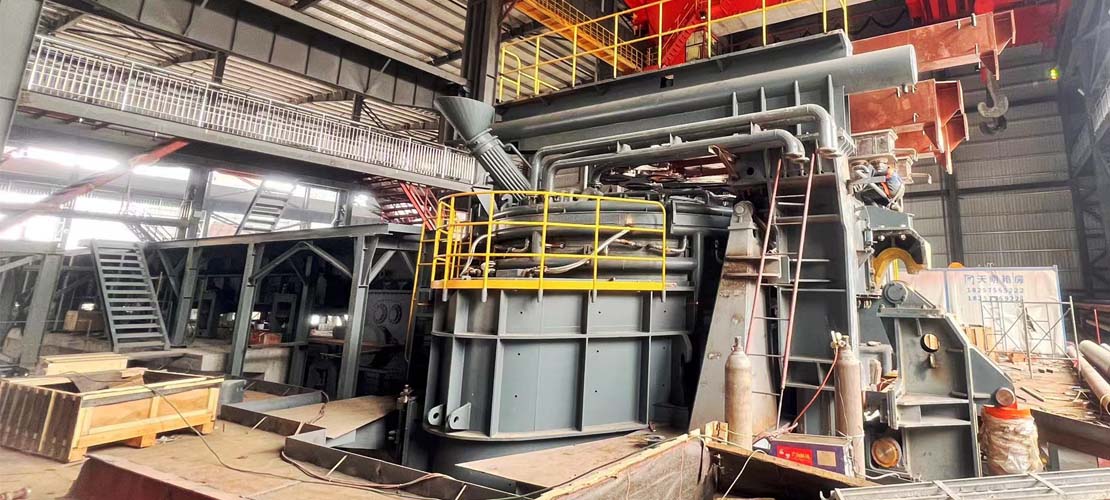Sep. 01, 2025

As a key process in modern steel production, the energy efficiency of electric arc furnace steelmaking directly impacts production costs and environmental benefits. Against the backdrop of the steel industry facing the dual challenges of resource constraints and a low-carbon transition, improving the energy efficiency of electric arc furnace steelmaking has become a key area for technological upgrading. The following discusses the technical principles, optimization measures, practical cases, and development trends.
Electric arc furnace steelmaking uses graphite electrodes to generate a high-temperature arc to melt scrap steel. Its energy consumption consists of three components: electrical energy, chemical energy, and physical heat. Of the total energy input of a typical electric arc furnace, electrical energy accounts for approximately 60%-70%. Chemical energy comes from heat released by oxidation reactions within the furnace, while physical heat is derived from parameters such as the scrap preheating temperature. Energy efficiency is typically measured in kWh/ton of steel. Internationally advanced standards can reach 300-350 kWh/ton, while most domestic companies still struggle with a range of 380-450 kWh/ton, leaving significant room for improvement.
Improving electric arc furnace energy efficiency requires the comprehensive application of multi-faceted technical approaches. During raw material pretreatment, implementing scrap sorting, screening, and cleaning can increase metal yield by 3%-5% and effectively reduce energy consumption for impurity removal during the smelting process. Scrap preheating technology, which uses electromagnetic induction or gas heating to raise the incoming material temperature to over 600°C, can reduce electricity consumption by 15%-20%. A European steel mill has achieved a technological breakthrough by using a vertical scrap preheating system, combined with flue gas waste heat recovery, to reduce electricity consumption per ton of steel to 330 kWh. Regarding power supply system optimization, dynamic adjustment of electrode position and current intensity, combined with an intelligent control system to match the melt pool impedance in real time, can increase energy utilization by 8%-12%.
A major domestic steel mill's transformation demonstrates the significant improvement in energy efficiency achieved through equipment upgrades and process optimization. The company invested in a fully enclosed scrap pretreatment center equipped with infrared sorting and crushing equipment, reducing the raw material impurity rate from 4.2% to 1.8%. The accompanying installation of a fourth-generation electromagnetic stirring system enhanced melt pool heat transfer efficiency and shortened the smelting cycle by 12 minutes. The introduction of a neural network-based energy management and control platform enables dynamic adaptation of power supply parameters to raw material conditions, resulting in an 18% reduction in annual power consumption, reaching an industry benchmark of 365 kWh per ton of steel.
Intelligent control is a new direction for improving energy efficiency. A German factory developed an electric arc furnace digital twin system. By collecting real-time data from over 2,000 sensors to build a virtual melt pool model, it can predict energy demand fluctuations 15 minutes in advance and dynamically adjust power supply strategies. This system controls power fluctuations to within ±5%, improving overall energy efficiency by 7.3%. An intelligent electrode control system developed by a domestic research institute uses machine vision to monitor arc morphology and combines fuzzy control algorithms to optimize electrode raising and lowering frequency, successfully reducing electrode consumption by 0.8 kg/ton.
The innovative application of waste heat recovery technology has brought significant benefits. A Japanese steel plant installed a waste heat boiler at the end of its flue gas purification system, converting 800°C flue gas into steam for power generation, generating annual revenue of 12 million yuan. A domestic company is piloting an organic Rankine cycle power generation system, utilizing waste heat from temperatures between 200 and 300°C to generate electricity. The system generates 18 million kWh of electricity annually, equivalent to saving 7,200 tons of standard coal. The widespread application of these technologies is gradually bringing the energy consumption of electric arc furnace processes closer to their theoretical limits.
Green energy integration is becoming a future trend. Sweden's HYBRIT project is testing hydrogen as an auxiliary fuel, replacing natural gas. During the pilot phase, it achieved a 35% reduction in CO2 emissions. An Austrian steel mill is integrating rooftop photovoltaic power generation with electric arc furnace operations, with photovoltaic power accounting for 18% of its total power, creating a new model for the deep integration of clean energy and steel production. These explorations provide technical support for the industry's low-carbon transition.
Improving the energy efficiency of electric arc furnace steelmaking is a systematic project, involving collaborative innovation across multiple aspects, including raw material management, equipment upgrades, intelligent control, and waste heat utilization. With the in-depth integration of digital technologies such as the Internet of Things and big data, and the continued increase in the use of clean energy, electric arc furnace processes will continue to evolve towards greater efficiency and cleaner production. This not only concerns the economic benefits of enterprises, but is also the only way for the steel industry to achieve its carbon neutrality goals. It requires all parties in industry, academia and research to strengthen collaboration and jointly promote technological innovation and industrial upgrading.
Latest News
Sep. 02, 2025
Energy Efficiency of Electric Arc Furnace Steelmaking
Sep. 01, 2025
Latest Products
Customized metallurgical machinery and equipment range: Electric Arc Furnace, Submerged Arc Furnace, LF Refining Furnace, Vacuum Furnace, Induction Furnace, Dust Remove System, Water Treatment Equipment, etc. Providing the most advanced equipment integration services, metallurgical equipment can be customized according to different needs of customers, and production capacity can be adjusted according to customer requirements.
Electric Arc Furnace
Submerged Arc Furnace
LF Refining Furnace
VD / VOD Vacuum Refining Furnace
Induction Furnace
Furnace Accessories
Navigation
E-mail: anna@srfurnace.com
Tel: +86 159 2955 5868
WhatsApp: +86 159 2955 5868
Add:
Room 102, Building 7A, Free Trade Xintiandi, Fengdong Avenue, Fengdong New Town, Xi'an City, Shaanxi Province
